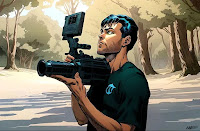Filmmaking is a multidisciplinary art form that blends storytelling, visual aesthetics, and technical prowess to create a captivating audiovisual experience. With the advent of technology and the democratization of filmmaking tools, aspiring filmmakers now have the opportunity to unleash their creativity and produce high-quality content. In this article, we delve into the intricate world of filmmaking, exploring its components, techniques, and the artistic mindset that propels it forward.
The Foundation: Storytelling
At the heart of every great film lies a compelling story. A well-crafted narrative serves as the backbone of a film, driving the audience's engagement and emotional investment. Filmmakers must carefully construct characters, conflicts, and resolutions that resonate with viewers. This often involves a deep exploration of human emotions, societal themes, and personal experiences. Whether it's a thrilling action movie or an intimate drama, a strong story paves the way for a memorable cinematic experience.
Pre-Production: The Blueprint
Before cameras start rolling, meticulous planning takes place during the pre-production phase. This includes scriptwriting, storyboarding, location scouting, casting, and designing the visual elements. A script acts as the blueprint, guiding the entire production process. Storyboards visually map out each scene, aiding the director's vision and assisting the cinematographer in achieving the desired shots. Location scouting ensures that the chosen settings align with the story's ambiance and aesthetic.
Casting is an art in itself, as the right actors bring characters to life, infusing them with depth and authenticity. The collaborative effort during pre-production sets the stage for a seamless shooting process.
Cinematography: Painting with Light
Cinematography is often referred to as "painting with light," as it involves capturing moving images through the lens of a camera. Cinematographers skillfully manipulate lighting, framing, composition, and camera movement to convey mood and emotion. The choice of lenses, angles, and camera movements affects the audience's perspective and engagement. From sweeping aerial shots to intimate close-ups, cinematography enhances the narrative's impact.
Visual Aesthetics: Production Design and Art Direction
Production design and art direction contribute significantly to a film's visual aesthetics. Production designers create the overall look and feel of the film's environment, ensuring that it complements the story. Art directors work closely with the production designer to bring these concepts to life, overseeing sets, props, costumes, and makeup. Their collective efforts create a visual language that enriches the storytelling and immerses the audience in the film's world.
Soundscapes and Music: Elevating Emotions
The auditory elements of a film are equally crucial in evoking emotions and enhancing the viewer's experience. Sound designers and composers collaborate to construct intricate soundscapes and compose original music. From subtle ambient sounds to dramatic orchestral scores, audio elements amplify the film's emotional depth. Every footstep, whisper, and note contributes to the immersive quality of the film, enveloping the audience in a multisensory journey.
Editing: Crafting the Narrative
Editing is where the raw footage is transformed into a coherent and engaging story. Editors sift through hours of material, selecting the best shots and sequences to piece together the final narrative. They control pacing, rhythm, and continuity, ensuring a seamless flow that keeps viewers engaged. Well-timed cuts, transitions, and visual effects contribute to the film's overall rhythm and impact.
Post-Production: Visual Effects and Color Grading
Post-production adds the finishing touches that refine the film's visual and auditory elements. Visual effects artists integrate computer-generated imagery (CGI) seamlessly with live-action footage, creating fantastical worlds and impossible scenarios. Color grading sets the film's mood and enhances its visual coherence, guiding the audience's emotional response through the manipulation of color and light.
Distribution and Exhibition: Sharing the Vision
Once the film is complete, the focus shifts to distribution and exhibition. In the digital age, filmmakers have various avenues to showcase their work, from traditional theater releases to streaming platforms. Effective marketing and distribution strategies ensure that the film reaches its intended audience, maximizing its impact and reach.
Conclusion
Filmmaking is a harmonious blend of artistry and technical proficiency, where every element converges to create a mesmerizing cinematic experience. From the inception of an idea to its final screening, each step in the filmmaking process demands passion, collaboration, and innovation. Aspiring filmmakers are presented with an unparalleled opportunity to harness their creativity and contribute their unique voices to the ever-evolving world of cinema. By embracing storytelling, visual aesthetics, sound design, and post-production techniques, filmmakers can pave the way for their journey into the realm of creative excellence.


0 Comments